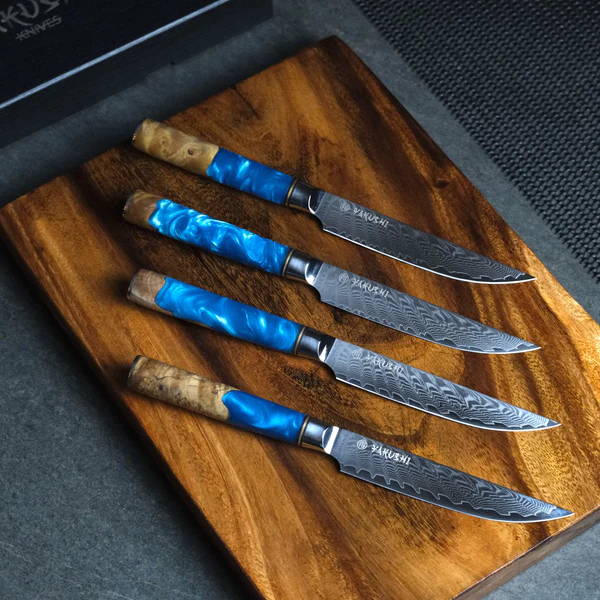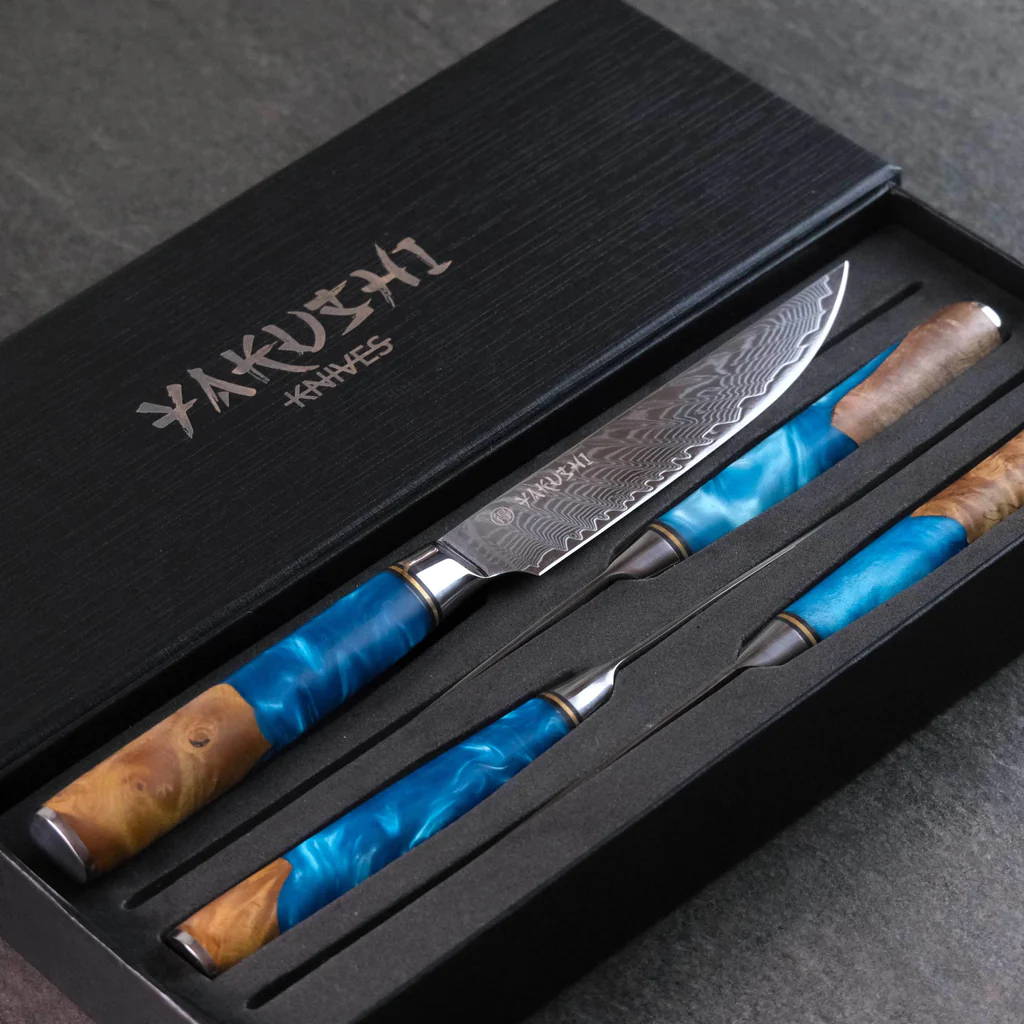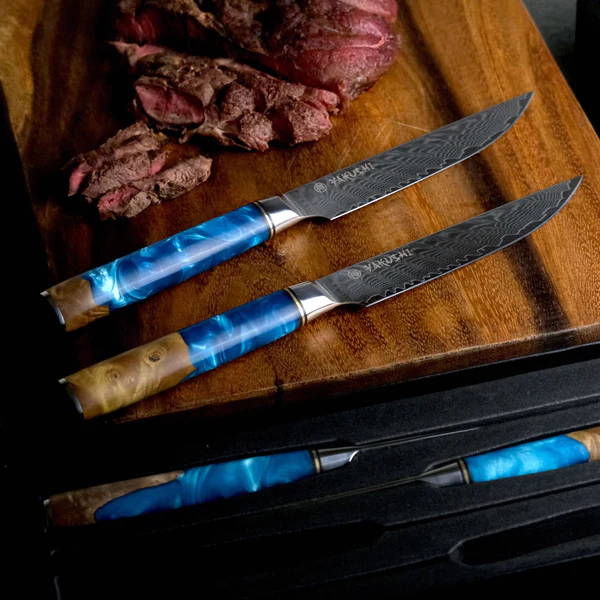The Essential Guide To Choosing
High-Quality Steak Knives

Factors to Consider

Edge Type: Serrated vs. Straight
Blade Design:
-
Serrated Blades: Serrated blades have a jagged, tooth-like edge that resembles a saw. The scalloped design is effective for cutting through tough surfaces without crushing softer interiors, making them suitable for crusty bread and tougher cuts of meat.
- Straight-Edged Blades: Non-serrated blades feature a straight, razor-sharp edge designed for smooth, clean cuts. They excel at slicing through meat without tearing the fibers, preserving the meat's juices, and providing a cleaner overall cut.
Honing Needs:
-
Serrated Blades: Serrated blades may initially cut through meat more quickly but can dull rapidly. Regular sharpening, including honing and stropping, is crucial to keep them performing well.
-
Straight-Edged Blades: While non-serrated blades may require more frequent sharpening, they tend to hold up better over time. Their smooth edge experiences less wear and tear, making them a lower-maintenance option.
Meat Cutting performance:
-
Serrated: Can be good for cutting through large cuts of meat but may not perform as well as straight-edged knives for slicing big cuts.Tends to cause more trauma to the meat, potentially leading to more juice loss during cutting and eating.
-
Straight-Edged: Typically performs better when slicing larger cuts of meat, providing cleaner cuts. This results in less damage to the meat, helping to retain flavorful juices and providing a juicier steak.
Full Tang vs. Partial Tang
Construction and Strength:
-
Full Tang: In a full tang steak knife, the blade extends from the tip to the end of the handle, creating a solid, continuous piece of metal. This construction provides maximum strength and durability, making full-tang knives suitable for heavy-duty tasks.
-
Partial Tang: Partial tang steak knives have a tang that does not extend the entire length of the handle. This design may compromise the overall strength of the knife, especially under heavy use or when exposed to lateral forces.
Weight and Balance:
-
Full Tang: These knives, due to the additional metal, are generally heavier. This added weight contributes to better balance, allowing for improved control and precision during cutting tasks.
- Partial Tang: Partial tang knives are typically lighter, and this can result in an unbalanced feel, with the weight distribution favoring the blade. This imbalance may affect the knife's maneuverability and control.

Intended Use:
-
Full Tang: Full Tang steak knives are ideal for cutting through thick steaks, bones, and other challenging materials.
- Partial Tang: These knives, on the other hand, may be suitable for lighter cutting tasks, such as slicing tender herbs or vegetables.
Material Used
For the Blade: -
-
Stainless Steel Blades: It is a popular choice for steak knife blades due to its corrosion resistance and stain resistance. It offers perfect strength and sharpness, making it versatile for slicing through meats. Stainless steel blades are also relatively easy to maintain and clean.
-
Carbon Steel Blades: Known for their durability, carbon steel blades can hold an edge for an extended period. However, they are more susceptible to rust compared to stainless steel. Carbon steel knives may be prone to chipping and require careful handling. However, they are relatively easy to sharpen.
-
Ceramic Blades: These blades are valued for their sharpness retention. Ceramic blades are lightweight but can be brittle and prone to chipping or breaking, especially on hard surfaces.
-
Forged Blades: Forged blades are crafted through the heating and shaping of metal. They are generally stronger and more durable compared to stamped blades. The forging process contributes to longevity and overall performance, making them a preferred choice for quality steak knives.
- German Stainless Steel: This type of stainless steel is renowned for its toughness, durability, and balanced combination of strength and sharpness. Often used in high-quality knives, including steak knives, German stainless steel provides reliable performance.
For the Handle
-
Wood Handles: Wood handles are the best options when it comes to the material of the knife’s handle. It’s because of the classic look and comfortable grip. They offer a timeless appeal to the table setting and come in various types, such as walnut, rosewood, or olive wood. However, wooden handles may require more maintenance to prevent drying or cracking.
-
Plastic Handles: The plastic handles are known for their affordability and lightweight nature. They are budget-friendly, easy to clean, and resistant to water damage but may lack the durability associated with other materials.
-
Stainless Steel Handles: These handles provide a sleek and modern appearance, complementing contemporary table settings. They are durable and corrosion-resistant but may have a heavier weight.
- Composite Handles: For better durability, good looks, and praca better durability, and practicality, you can go for composite handles, a combination of wood and plastic; They can be durable and resilient, inheriting positive characteristics from their constituent materials. These handles may come in various colors and patterns.
Caring for Your Steak Knives (Cleaning and maintenance tips, Storage options to prevent damage.)

Cleaning Techniques:
- Handwash with warm water, mild dish soap, and a soft sponge or cloth.
- Avoid dishwashers to prevent damage from high heat and harsh detergents.
- For tough stains or rust, create a baking soda and water paste, gently rub, and rinse immediately.
- Thoroughly rinse and dry the knives immediately to prevent further oxidation.
Sharpening Methods:
- Regularly hone with honing steel to realign the blade's edge.
- Seek professional sharpening if knives become excessively dull; avoid machine sharpening.
Proper Storage Practices:
- Avoid loose storage in drawers to prevent blade dulling from contact.
- Use a knife block, magnetic strip, or knife roll with individual slots.
- Consider blade covers or sheaths for protection during storage.



Leave a comment
This site is protected by hCaptcha and the hCaptcha Privacy Policy and Terms of Service apply.